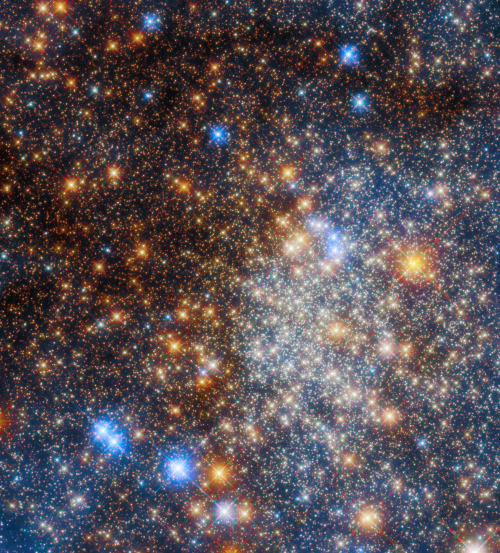Happy Wednesday! It's Time For An Astronomy Word Of The Day!

Happy Wednesday! It's time for an astronomy word of the day!
Asterism - an asterism is any prominent star pattern that isn’t a whole constellation, such as the Northern Cross or the Big Dipper (pictured below)
Definition from: https://skyandtelescope.org/astronomy-terms/ Image from: https://skyandtelescope.org/astronomy-news/a-new-way-to-see-the-big-dipper/
More Posts from Bsuobservatory and Others
The Seyfert galaxy NGC 5985 (on the left) contains an Active Galactic Nucleus (AGN).
AGN are so. Amazing.
In the dead center of the galaxy lies a supermassive black hole—and a large amount of other matter spiraling into it, caught in the gravitational well. As matter falls in, it accelerates to relativistic speeds, ripping apart until even atoms are split into plasma, and because plasma is not electrically neutral the metaphorical whirlwind of it generates an extremely strong electromagnetic field.
That field blasts matter away from the black hole in jets. These can be truly enormous. A single jet emanating from the black hole in the monstrous elliptical galaxy M87 is roughly ten times the length of our entire Milky Way Galaxy.
Seyfert galaxies are calmer than that, but the mechanism is the same. Bright, powerful AGN tend to be found in galaxies further from our own, while Seyferts dominate the AGN population in our local universe.
At BSU, we've imaged Markarian 421, a type of AGN called a blazar, so-named because the jet is aimed almost directly toward Earth.: "blazing" bright. We're in the process of studying our data, but the eventual goal is to determine limits for the mass of the black hole powering it. The student who spearheaded that research is now pursuing a Ph.D. at Purdue University!

2023 July 1
Three Galaxies in Draco Image Credit & Copyright: David Vernet , Jean-François Bax , Serge Brunier, OCA/C2PU
Explanation: This tantalizing trio of galaxies sometimes called the Draco Group, is located in the northern constellation of (you guessed it) Draco, the Dragon. From left to right are face-on spiral NGC 5985, elliptical galaxy NGC 5982, and edge-on spiral NGC 5981, all found within this single telescopic field of view that spans a little more than the width of the full moon. While the group is far too small to be a galaxy cluster, and has not been catalogued as a compact galaxy group, the three galaxies all do lie roughly 100 million light-years from planet Earth. Not as well known as other tight groupings of galaxies, the contrast in visual appearance still makes this triplet an attractive subject for astroimagers. On close examination with spectrographs, the bright core of striking spiral NGC 5985 shows prominent emission in specific wavelengths of light, prompting astronomers to classify it as a Seyfert, a type of active galaxy. This impressively deep exposure hints at a faint dim halo along with sharp-edged shells surrounding elliptical NGC 5982, evidence of past galactic mergers. It also reveals many even more distant background galaxies.
∞ Source: apod.nasa.gov/apod/ap230701.html
Wed. 4/16: Check back for our weather decision after 4 pm! The forecasts disagree.

“What in the world is that?” That’s a natural reaction when you first see this Hubble Space Telescope image of LL Pegasi. The extremely dim spiral pattern is real, and its regularity suggests a periodic origin for the nebula’s shape.
The spiral is thought to arise because LL Pegasi is a binary system, with a star that is losing material and a companion star orbiting it. The companion’s gravitational influence helps sculpt the nebula. The spacing between layers in the spiral reflects the 800-year orbital period of the binary.
Credit: ESA/NASA & R. Sahai.
ALT TEXT: At center left, a faint spiral structure with wide bands has a dark, dusty center. To its right, a bright white star displays four prominent diffraction spikes. A handful of smaller, more distant background galaxies are also scatted throughout the image.
Wed. Apr. 17: Another cloudy night, so we'll be closed. We'll try again next week.
Wed. Aug. 14 - The weather looks good tonight so far, but check back later for our final weather decision. If it stays nice enough, we'll be open from 8:30 - 9:30 pm!

The Dolphin Head Nebula (Sh2-308, right) and Sh2-303 (left) // Jim Thommes

Pumpkin space latte, anyone? ☕
Hubble captured this festive array of stars, Terzan 12, found in the Milky Way about 15,000 light-years from Earth. The stars in this cluster are bound together by gravity in a sphere-like shape and are shrouded in gas and dust. As the starlight travels through that gas and dust to Earth, blue light scatters, leaving the redder wavelengths to come through.
Download the full-resolution image here.
Make sure to follow us on Tumblr for your regular dose of space!

"The Imperfect Angel Nebula", NGC 2170 // zombi
Video of the Day!
Hubble has discovered that Jupiter’s red spot - a storm larger than Earth - is wobbling!

Comet Nishimura Credit: Peter Kennett
-
 twoofhearts21 liked this · 8 months ago
twoofhearts21 liked this · 8 months ago -
 bsuobservatory reblogged this · 8 months ago
bsuobservatory reblogged this · 8 months ago

STEM Education, Astrophysics Research, Astrophotography, and Outreach located at 24 Park Ave., Bridgewater MA. You'll find us on the two outdoor balconies on the 5th floor, and you'll find our official website here: https://www.bridgew.edu/center/case/observatory .
150 posts